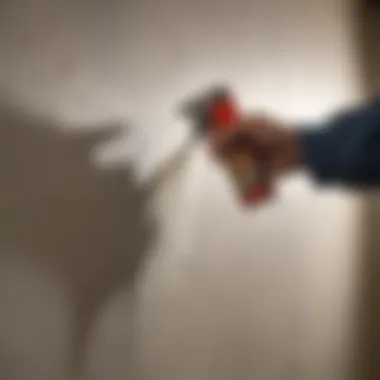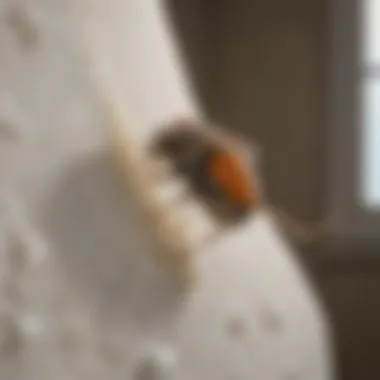Mice and Spray Foam: Pest Control Insights


Intro
Managing pest populations is a task that requires knowledge and strategy. One of the key areas where effective pest control comes into play is the relationship between mice and spray foam insulation. Understanding this relationship is essential for homeowners who wish to maintain an effective barrier against rodents while considering the practical uses of spray foam.
Although spray foam is often celebrated for its insulating properties, it can also present challenges when it serves as an unintended haven for pests. Mice are notorious for seeking warmth and shelter, making homes with certain types of insulation more attractive. Thus, comprehending how spray foam interacts with mice can enhance pest management strategies.
This article will explore various aspects including how to identify signs of mouse infestations, effective prevention strategies, and various treatment options available. Equipping yourself with comprehensive information can lead to more informed decisions and improved outcomes in controlling mouse populations within your home.
Pest Identification
Detailed Descriptions of Common Pests
Mice are small rodents that belong to the family Muridae. The two most common species found in homes are the house mouse and the deer mouse.
- House Mouse: This species is typically gray or brown in color with a slender body, large ears, and a long tail. Adult house mice usually weigh about 0.5 to 1 ounce.
- Deer Mouse: This rodent often has a lighter coloration with a whitish belly and dark brown or gray upper parts. It prefers rural areas but can also invade homes, especially in the winter.
Signs and Symptoms of Infestations
Identifying a mouse infestation early can minimize damage and potential health risks. Here are common signs:
- Droppings: Small, dark pellets that are often found near food sources or nesting areas.
- Gnaw marks: Mice will chew on various materials, including wood and plastic, to expand their nests or access food.
- Nests: These are usually made of shredded paper or fabric and can be found in hidden areas within the home.
- Tracks and Smudges: Mice often leave greasy smudges along their pathways, which is particularly noticeable in dust or light-colored surfaces.
Prevention Strategies
Home Maintenance Tips for Pest Prevention
Effective pest control starts with proactive measures. Here are some strategies:
- Seal Entry Points: Inspect the exterior of your home for cracks and gaps. Use appropriate materials to seal these areas.
- Store Food Properly: Keep all food in airtight containers. This reduces the likelihood of attracting mice.
- Maintain Cleanliness: Regularly clean kitchens and dining areas to eliminate crumbs and food residues.
Natural Deterrents and Barriers
Certain natural methods can also deter mice. Consider the following options:
- Peppermint Oil: Mice are believed to dislike the strong scent. Placing cotton balls soaked in peppermint oil may help.
- Ultrasonic Repellents: These devices emit high-frequency sound waves that are uncomfortable for rodents, encouraging them to leave.
Treatment Options
Overview of Chemical vs. Natural Treatments
When it comes to treating mouse infestations, both chemical and natural treatments have their pros and cons.
- Chemical Treatments: Typically quick and effective, but they may carry risks to pets and children.
- Natural Treatments: Generally safer but may require more time and consistent application.
Step-by-Step Guides for DIY Treatments
If opting for DIY solutions, here are some basic protocols:
- Identify the areas where signs of mice are present.
- Set Traps: Use snap traps or catch-and-release traps, placing them in strategic locations near signs of activity.
- Bait Traps: Utilize food items, like peanut butter or seeds, to attract mice.
- Monitor the traps regularly and dispose of any caught pests responsibly.
Understanding the relationship between mice and spray foam insulation is crucial for reducing infestations and maintaining a healthy home environment. This guide equips homeowners with essential information to tackle pest issues effectively.
Preamble to Mice in Residential Areas
Mice are often viewed as small, harmless creatures. However, their presence in residential spaces can lead to significant issues for homeowners. Understanding the role that mice play in our living environments is critical, especially in the context of pest control. Knowledge about their habits, nesting behaviors, and associated health risks can inform effective solutions for managing infestations.


Understanding Mouse Behavior
Mice are social animals and tend to live in family groups. They are primarily nocturnal, which makes them challenging to spot. They rely on their acute sense of smell and touch to navigate their surroundings. They are also curious in nature, often exploring their environment for food and shelter. Understanding these behaviors helps homeowners predict where mice might be entering their homes and how they may behave once inside.
Did you know that mice have the capability to squeeze through tiny openings? This is why sealing your house's cracks and crevices is crucial in preventing their entry. Observing their activity pattern can assist in identifying nesting sites or feeding areas, which is essential for effective pest management.
Common Types of Mice Found in Homes
Several species of mice may invade residential areas, but the most prevalent include the House Mouse and the Deer Mouse. The House Mouse is generally gray or brown with a pointy snout and large ears. They thrive in urban areas, often found in kitchens or pantries. In contrast, Deer Mice can carry hantavirus, posing serious health risks, and are typically found in rural settings. Knowing which species is potentially invading your home is important; different species may require different control strategies.
Here are some common types of mice found in homes:
- House Mouse
- Deer Mouse
- Field Mouse
Each of these species exhibits distinct nesting habits, diet preferences, and potential impact on human health, making identification a key step in developing a pest management plan.
Health Risks Associated with Mice
The presence of mice in a household is not just a nuisance; it also poses real health risks. Mice can be carriers of various diseases, including salmonella, leptospirosis, and hantavirus. Their droppings, urine, and saliva can contaminate food and surfaces, increasing the potential for disease transmission. Furthermore, mice can trigger allergies and asthma in sensitive individuals through their fur and waste products.
"Mice are silent invaders that can compromise both health and home safety."
This underlines the necessity of addressing mouse infestations proactively. Effective pest control measures must consider health implications, incorporating strategies that minimize risks to residents.
In summary, recognizing the complexities of mice behavior, identifying the species that invade homes, and understanding the potential health risks are fundamental components in developing effective pest control strategies. This foundation sets the stage for exploring how materials like spray foam insulation interact with these variables in a residential context.
Prelims to Spray Foam Insulation
Spray foam insulation has gained traction in recent years as a method for improving energy efficiency and pest control in residential areas. It is essential to understand its role in pest management, particularly in relation to mice. The dual nature of spray foam—acting as both a barrier to entry and a possible nesting material for rodents—makes it a relevant subject in this discussion. Homeowners should be aware of how spray foam insulation can impact mouse behavior and the overall pest management strategy.
Understanding this insulation type allows homeowners to make informed decisions about pest prevention methods. Applying spray foam correctly can greatly reduce the chances of rodent infestations while providing significant thermal insulation advantages. However, without proper application and consideration of its characteristics, it can inadvertently create new issues for homeowners dealing with rodent problems.
What is Spray Foam Insulation?
Spray foam insulation is a type of insulation made from a mixture of chemicals that expand when sprayed onto surfaces. Once applied, it hardens and creates an air-tight barrier. It is favored for its ability to fill gaps and cracks, which standard insulation cannot always accomplish. Moreover, this insulation comes in two primary types: open-cell and closed-cell. Each serves unique purposes in insulation and pest control.
Types of Spray Foam Insulation
- Open-cell spray foam: This type is less dense and can absorb moisture, making it a suitable option for interior spaces such as attics and walls. One downside is its reduced effectiveness when it comes to preventing pest entry, as mice may find it more amenable for nesting.
- Closed-cell spray foam: This type is denser and waterproof. It is excellent at providing insulation against temperature fluctuations. Closed-cell foam can deter moisture from entering homes, which is crucial for pest prevention. But its rigidity may also fortify areas where mice can tunnel away.
Each type's unique properties should guide homeowners in their selection based on specific goals and existing pest problems.
Benefits of Spray Foam Insulation
Spray foam insulation offers numerous benefits:
- Energy efficiency: Properly installed spray foam improves energy use in homes, lowering heating and cooling costs. This is crucial for overall home maintenance and utility budgeting.
- Air sealing: It effectively seals gaps that traditional insulation might miss. This barrier can stop air leaks that rodents use as entry points.
- Moisture control: High-quality spray foam can prevent moisture damage. By minimizing damp spaces, it reduces the likelihood of pest infestations.
- Structural integrity: Closed-cell spray foam adds added rigidity to structures, making it harder for mice to chew through or find entry.
Incorporating spray foam insulation can transform a property into a more energy-efficient and pest-resistant environment, but it is vital to understand and apply it correctly to realize its full potential.
The Connection Between Mice and Spray Foam
Understanding the relationship between mice and spray foam insulation is crucial for both residential comfort and effective pest control. Mice are adaptive creatures known for their ability to find shelter in homes. Spray foam, often employed for insulation purposes, can inadvertently serve as a refuge for these rodents. This duality makes it essential for homeowners to understand how spray foam can both deter and attract mice, impacting pest management strategies significantly.
How Spray Foam Can Deter Mice
Spray foam insulation can create a more inhospitable environment for mice when correctly applied. It fills gaps and cracks in walls, ceilings, and foundations, which are potential entry points for these pests. By sealing these areas tightly, spray foam reduces accessibility, presenting a formidable barrier.


In essence, using spray foam strategically can contribute to integrated pest management. The insulation can disrupt nesting behavior, as it is less accommodating than traditional insulations. Mice typically prefer soft nesting materials like cellulose or fiberglass. When encountering a firm, sealed surface, they might opt for easier habitats elsewhere. However, the effectiveness of spray foam largely hinges on proper installation and thorough application in critical areas of the home.
The Drawbacks of Spray Foam for Rodent Control
Despite its benefits, spray foam insulation does come with certain drawbacks regarding rodent control. First and foremost, if the foam is applied improperly, it could lead to spaces that are inadvertently left exposed. These small openings can serve as new access points and may contribute to pest infestations rather than diminishing them. Additionally, it's essential to note that once mice find a route into a house, they may tunnel through spray foam to nest.
Moreover, spray foam can retain moisture if not adequately managed, creating an environment conducive to both mold and pests. Mice are drawn to damp conditions. If your foam insulation traps moisture, it may not only be a health hazard but also a welcomed environment for rodents. Therefore, having a well-thought-out moisture management plan is crucial when using spray foam as insulation.
Case Studies of Effectiveness
Examining real-world applications can shed light on the effectiveness of spray foam in deterring mice. For instance, a family in rural Minnesota adopted spray foam insulation during a home renovation. They reported a marked decrease in mouse sightings post-application, attributing this to newly sealed eaves and wall joints.
On the contrary, a homeowner in New Jersey employed spray foam to renovate an older home but did not address identified entry points first. After installation, the household faced a considerable mouse issue, highlighting that installation without addressing prior vulnerabilities leads to ineffective results.
"Effective application of spray foam insulation can significantly influence rodent activity within a home, but it is no substitute for comprehensive pest management strategies."
To sum up, understanding the connection between mice and spray foam enhances the homeowner's ability to create a pest-resistant environment.
Spray Foam as a Barrier to Rodents
Spray foam insulation offers a unique approach in the quest to combat rodent invasions. Its properties allow homeowners to improve energy efficiency, while simultaneously creating barriers against pests like mice. It is essential to understand how spray foam insulation can guard your home. This section elaborates on the mechanisms through which spray foam acts as a deterrent for rodents, optimal installation techniques, and how it integrates with other pest control methods.
Mechanisms of Prevention
When spray foam is applied, it expands and fills gaps, cracks, and voids in walls, ceilings, and floors. This expansion makes it difficult for mice, which typically exploit small openings, to enter. The core material of spray foam is quite different from traditional insulation, as it is dense and often irritating to rodent fur. Moreover, its sticky texture can trap mice, preventing them from navigating freely within a structure.
"Spray foam not only insulates but also creates a physical barrier that discourages rodent entry and nesting."
In addition to its structural advantages, certain spray foams contain additives that can repel rodents. These additives can emit scents that are unappealing to mice, causing them to avoid treated areas. However, these aspects can depend on the specific product used; thus, selecting the right foam is critical for enhancing effectiveness.
Installation Techniques for Optimal Results
For spray foam insulation to function effectively as a barrier against rodents, proper installation is paramount. First, it is essential to conduct a thorough inspection of your home for any existing cracks and gaps. Focus on high-risk areas such as pipes, vents, and around windows or doors.
Once the inspection is complete, keep these guidelines in mind:
- Choose the right type of spray foam — closed-cell foam generally provides a more robust barrier than open-cell variants.
- Ensure that the spray foam is applied evenly and thoroughly. Incomplete coverage can leave entry points exposed.
- It is advisable to hire professionals for application; they can assess your home accurately and ensure the insulation meets building codes.
After installation, monitoring for rodent activity is important. Regular inspections can help identify potential breaches in the barrier and allow for timely remediation.
Integration with Other Pest Control Methods
Utilizing spray foam insulation alone may not guarantee complete prevention of rodent infestations. It works best when incorporated into a comprehensive pest management strategy. This approach may include:
- Exclusion: Use barriers such as steel mesh screens, which can complement spray foam by blocking entry points.
- Trapping: Position traps near identified entry points to capture any rodents that may find their way inside.
- Sanitation: Maintain cleanliness in and around your home. Properly store food and eliminate clutter, reducing attractants for mice.
The synergy of these strategies with spray foam insulation not only enhances your defense against rodents but also prepares your home to withstand future infestations. It is an effective method to ensure that your living space remains uninviting to unwanted guests.
Limitations of Spray Foam Insulation
Spray foam insulation holds promise as a tool for pest control, particularly in relation to managing mouse populations. However, it is essential to explore the limitations of its effectiveness. Recognizing these constraints allows homeowners to make informed decisions about pest management. Without understanding the possible shortcomings, one may overestimate its efficacy.
Potential for Mice Nesting
While spray foam creates a barrier against rodents, it can also inadvertently offer suitable nesting areas for mice. The foam's structure can trap warm air, making it an attractive location for nesting. Mice seek cozy and sheltered environments, and if spray foam is improperly applied or not monitored, it may create ideal conditions for them to thrive. This aspect reinforces the need for regular inspections and maintenance post-installation to ensure that the intended barrier is not functioning the opposite way.


Impact of Environmental Conditions
Environmental factors significantly influence the effectiveness of spray foam insulation in pest control. Extreme weather can affect the foam's integrity over time. For instance, prolonged exposure to moisture can cause the foam to degrade, leading to gaps that mice can exploit. Additionally, temperature fluctuations may result in the shrinkage of the foam, granting entry points for pests. Homeowners should be aware of these conditions and consider their local climate when implementing spray foam as a pest control method. Proper installation and the use of high-quality materials can mitigate some of these issues.
Alternatives to Spray Foam
In light of the limitations discussed, exploring alternatives to spray foam insulation is vital for comprehensive pest control. Other options may include:
- Fiberglass Insulation: Less appealing to rodents and can be more effective in certain climates.
- Cellulose Insulation: Made from recycled paper, it is treated to deter pests while being environmentally friendly.
- Barrier Systems: Physical barriers such as steel mesh and rodent-proof materials may restrict entry more effectively than foam alone.
Each alternative has its benefits and potential drawbacks, requiring careful evaluation based on specific pest control needs and structural conditions.
Understanding the limitations of spray foam insulation provides valuable context for households seeking pest management solutions. The goal is to incorporate spray foam wisely while recognizing where additional measures may be necessary.
Effective Pest Control Strategies
Pest control strategies are critical to managing rodent populations effectively. The relationship between mice and spray foam insulation underscores the need for thoughtful approaches. When considering pest management, it's essential to account for multiple factors such as existing conditions, types of insulation, and the methods employed.
Implementing effective pest control strategies involves several components that work in unison. First, recognizing the signs of mice infestation is vital. Early detection allows homeowners to act promptly, potentially minimizing damage and health risks. In addition, implementing a comprehensive plan can deter future infestations and establish a long-term solution.
Comprehensive Home Inspection
A thorough home inspection serves as the cornerstone of effective pest control strategies. Regular inspections help identify signs of rodent activity and potential entry points. Homeowners should consider engaging a pest control professional to conduct these inspections. They are trained to spot indicators that may go unnoticed by an untrained eye.
During the inspection, a focus on areas where insulation is present is critical. Places like attics, basements, and walls should be scrutinized. The aim is to determine not just the presence of mice, but also if the existing spray foam insulation serves as a barrier or a nesting site. Comprehensive home inspections should include a review of:
- Exterior areas: Look for gaps, cracks, or openings around doors, windows, and foundations that may allow mice entry.
- Interior areas: Check for droppings, nests, and chew marks near insulation materials, especially spray foam.
- Ventilation systems: Insulation used in ducts can be a hidden spot for mice.
Identifying Entry Points
Correctly identifying entry points is essential for a robust pest control strategy. Mice can navigate surprisingly small spaces. Identifying these points is the first step in fortifying the home against rodents. Common entry points include:
- Cracks and crevices: Foundations, along walls, and around pipes can be vulnerable spots.
- Roofline: Gaps around vents and chimneys can provide access from above.
- Basement and crawl spaces: Areas that are often dark and neglected can become homes for nesting.
By sealing these entry points with appropriate materials, including added spray foam, homeowners can significantly reduce the chance of an infestation taking hold.
Combining Methods for Maximum Efficacy
To truly maximize the efficacy of pest control measures, combining methods is a practical approach. Effective strategies often incorporate both preventive and reactive tactics. Some methods to consider include:
- Sealing off potential entry points: Use high-quality materials like silicone or additional spray foam to block gaps.
- Trapping and baiting: Deploy traps in strategic locations to reduce existing populations.
- Using complementary insulation: Combining spray foam with other types of insulation material may deter mice better than spray foam alone.
A combination of techniques tailored to specific conditions can lead to a more comprehensive solution. It is important to remain vigilant and adapt methods as conditions change. Effective pest control strategies provide a path to managing rodent activity and safeguarding homes.
Ending and Recommendations
The relationship between mice and spray foam insulation is not merely an academic interest; it carries significant implications for effective pest management in residential environments. Homeowners must keenly understand this interaction to make informed decisions. This final section summarizes vital points and provides actionable recommendations based on the preceding discussions.
Understanding your specific pest control needs is paramount. Not all homes experience rodent problems to the same extent, and factors such as location, construction type, and existing insulation will affect the strategy you need to adopt. It’s crucial to assess your premises thoroughly before selecting a pest control solution. Take note of where mice may be gaining access and how your insulation interacts with these areas. In some cases, homeowners may choose to consult pest control professionals for a comprehensive analysis, ensuring all options are considered.
This evaluation will lead to better choices, potentially saving both time and money in the long run.
Evaluating Your Pest Control Needs
When evaluating pest control needs, consider each element of your home. Begin with a detailed inspection for signs of rodent activity, such as droppings or chewed items. Identify potential entry points, which often include gaps in walls, around pipes, or under doors. Addressing these points can significantly minimize the risk of infestation.
Additionally, consider the current state of your insulation. Spray foam, while beneficial in many instances, may have limitations. For adequate protection, ensure the insulation is in good condition and complements other pest control methods. Testing your home for moisture issues is also wise, as damp environments attract mice.
Moving Forward with Spray Foam Insulation
As you contemplate the implementation of spray foam insulation as a pest control strategy, careful planning is essential. Research various types of spray foam and their effectiveness in preventing rodent entry. Ensure that the installation is performed expertly, as poor application may actually create more entry points. It is advisable to hire a reputable contractor familiar with pest control applications to maximize results.
Finally, consider integrating spray foam with other pest control measures. For instance, physical barriers or traps can work hand-in-hand with the insulation to create a comprehensive strategy. Keeping consistent monitoring practices in place will help you stay ahead of any pest issues. By remaining proactive rather than reactive, you will increase your chances of maintaining a pest-free environment.



